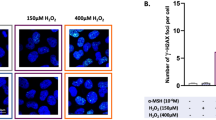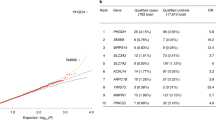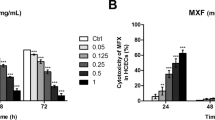Abstract
Focal dermal hypoplasia (FDH) is an X-linked developmental disorder with male lethality characterized by patchy dermal hypoplasia, skeletal and dental malformations, and microphthalmia or anophthalmia. Recently, heterozygous loss-of-function mutations in the PORCN gene have been described to cause FDH. FDH shows some clinical overlap with the microphthalmia with linear skin defects (MLS) syndrome, another X-linked male lethal condition, associated with mutations of HCCS in the majority of cases. We performed DNA sequencing of PORCN in 13 female patients with the clinical diagnosis of FDH as well as four female patients with MLS syndrome and no mutation in HCCS. We identified PORCN mutations in all female patients with FDH. Eleven patients seem to have constitutional PORCN alterations in the heterozygous state and two individuals are mosaic for the heterozygous sequence change in PORCN. No PORCN mutation was identified in the MLS-affected patients, providing further evidence that FDH and MLS do not overlap genetically. X chromosome inactivation (XCI) analysis revealed a random or slightly skewed XCI pattern in leukocytes of individuals with intragenic PORCN mutation suggesting that defective PORCN does not lead to selective growth disadvantage, at least in leukocytes. We conclude that the PORCN mutation detection rate is high in individuals with a clear-cut FDH phenotype and somatic mosaicism can be present in a significant proportion of patients with mild or classic FDH.
Similar content being viewed by others
Log in or create a free account to read this content
Gain free access to this article, as well as selected content from this journal and more on nature.com
or
Accession codes
References
Goltz RW, Peterson WC, Gorlin RJ, Ravits HG : Focal dermal hypoplasia. Arch Dermatol 1962; 86: 708–717.
Goltz RW : Focal dermal hypoplasia syndrome. An update. Arch Dermatol 1992; 128: 1108–1111.
Van den Veyver IB : Microphthalmia with linear skin defects (MLS), Aicardi, and Goltz syndromes: are they related X-linked dominant male-lethal disorders? Cytogenet Genome Res 2002; 99: 289–296.
Ballabio A, Andria G : Deletions and translocations involving the distal short arm of the human X chromosome: review and hypotheses. Hum Mol Genet 1992; 1: 221–227.
Lindsay EA, Grillo A, Ferrero GB et al: Microphthalmia with linear skin defects (MLS) syndrome: clinical, cytogenetic, and molecular characterization. Am J Med Genet 1994; 49: 229–234.
Naritomi K, Izumikawa Y, Nagataki S et al: Combined Goltz and Aicardi syndromes in a terminal Xp deletion: are they a contiguous gene syndrome? Am J Med Genet 1992; 43: 839–843.
Donnenfeld AE, Graham Jr JM, Packer RJ, Aquino R, Berg SZ, Emanuel BS : Microphthalmia and chorioretinal lesions in a girl with an Xp.22.2-pter deletion and partial 3p trisomy: clinical observations relevant to Aicardi syndrome gene localization. Am J Med Genet 1990; 37: 182–186.
Happle R, Daniels O, Koopman RJ : MIDAS syndrome (microphthalmia, dermal aplasia, and sclerocornea): an X-linked phenotype distinct from Goltz syndrome. Am J Med Genet 1993; 47: 710–713.
Mücke J, Happle R, Theile H : MIDAS syndrome respectively MLS syndrome: a separate entity rather than a particular lyonization pattern of the gene causing Goltz syndrome. Am J Med Genet 1995; 57: 117–118.
Wimplinger I, Morleo M, Rosenberger G et al: Mutations of the mitochondrial holocytochrome c-type synthase in X-linked dominant microphthalmia with linear skin defects syndrome. Am J Hum Genet 2006; 79: 878–889.
Grzeschik KH, Bornholdt D, Oeffner F et al: Deficiency of PORCN, a regulator of Wnt signaling, is associated with focal dermal hypoplasia. Nat Genet 2007; 39: 833–835.
Wang X, Reid Sutton V, Omar Peraza-Llanes J et al: Mutations in X-linked PORCN, a putative regulator of Wnt signaling, cause focal dermal hypoplasia. Nat Genet 2007; 39: 836–838.
Clements SE, Wessagowit V, Lai-Cheong JE, Arita K, McGrath JA : Focal dermal hypoplasia resulting from a new nonsense mutation, p.E300X, in the PORCN gene. J Dermatol Sci 2008; 49: 39–42.
Leoyklang P, Suphapeetiporn K, Wananukul S, Shotelersuk V : Three novel mutations in the PORCN gene underlying focal dermal hypoplasia. Clin Genet 2008; 73: 373–379.
Takada R, Satomi Y, Kurata T et al: Monounsaturated fatty acid modification of Wnt protein: its role in Wnt secretion. Dev Cell 2006; 11: 791–801.
Willert K, Brown JD, Danenberg E et al: Wnt proteins are lipid-modified and can act as stem cell growth factors. Nature 2003; 423: 448–452.
Morleo M, Pramparo T, Perone L et al: Microphthalmia with linear skin defects (MLS) syndrome: clinical, cytogenetic, and molecular characterization of 11 cases. Am J Med Genet A 2005; 137: 190–198.
Kherbaoui-Redouani L, Eschard C, Bednarek N, Morville P : (Cutaneous aplasia, non compaction of the left ventricle and severe cardiac arrhythmia: a new case of MLS syndrome (microphtalmia with linear skin defects)). Arch Pediatr 2003; 10: 224–226.
Morleo M, Franco B : Dosage compensation of the mammalian X chromosome influences the phenotypic variability of X-linked dominant male-lethal disorders. J Med Genet 2008; 45: 401–408.
Houge G, Oeffner F, Grzeschik KH : An Xp11.23 deletion containing PORCN may also cause angioma serpiginosum, a cosmetic skin disease associated with extreme skewing of X-inactivation. Eur J Hum Genet 2008; 16: 1027–1028.
Froyen G, Bauters M, Boyle J et al: Loss of SLC38A5 and FTSJ1 at Xp11.23 in three brothers with non-syndromic mental retardation due to a microdeletion in an unstable genomic region. Hum Genet 2007; 121: 539–547.
Blinkenberg EO, Brendehaug A, Sandvik AK, Vatne O, Hennekam RC, Houge G : Angioma serpiginosum with oesophageal papillomatosis is an X-linked dominant condition that maps to Xp11.3-Xq12. Eur J Hum Genet 2007; 15: 543–547.
Franco B, Ballabio A : X-inactivation and human disease: X-linked dominant male lethal disorders. Curr Opin Genet Dev 2006; 16: 254–259.
Migeon BR : Why females are mosaics, X-chromosome inactivation, and sex differences in disease. Gend Med 2007; 4: 97–105.
Van den Veyver IB : Skewed X inactivation in X-linked disorders. Semin Reprod Med 2001; 19: 183–191.
Acknowledgements
We are grateful to the patients and their parents. The results summarized here are part of the MD thesis of May-Britt Harmsen at the University of Hamburg. We thank Inka Jantke for skillful technical assistance, Isabella Wimplinger for sequence analysis of HCCS and X chromosome inactivation analysis, Manuela Morleo and Brunella Franco for copy number analysis of HCCS exons, and Stephan Schneider for his constant support to obtain material from patient FDH5.
Author information
Authors and Affiliations
Corresponding author
Rights and permissions
About this article
Cite this article
Harmsen, MB., Azzarello-Burri, S., García González, M. et al. Goltz–Gorlin (focal dermal hypoplasia) and the microphthalmia with linear skin defects (MLS) syndrome: no evidence of genetic overlap. Eur J Hum Genet 17, 1207–1215 (2009). https://doi.org/10.1038/ejhg.2009.40
Received:
Revised:
Accepted:
Published:
Issue date:
DOI: https://doi.org/10.1038/ejhg.2009.40
Keywords
This article is cited by
-
Goltz-Gorlin Syndrome: Revisiting the Clinical Spectrum
The Indian Journal of Pediatrics (2018)
-
Expanding the phenotypic spectrum of PORCN variants in two males with syndromic microphthalmia
European Journal of Human Genetics (2015)
-
Novel Mutation in a Child with Goltz Syndrome
The Indian Journal of Pediatrics (2012)



